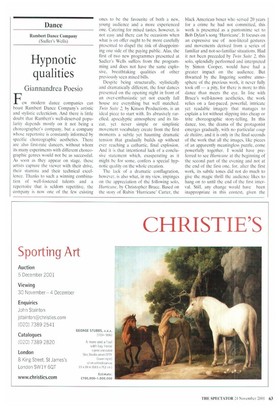Rambert Dance Company (Sadler's Wells)
Hypnotic qualities
Giannandrea Poesio
Few modern dance companies can boast Rambert Dance Company's artistic and stylistic eclecticism. And there is little doubt that Rambert's well-deserved popularity depends mostly on it not being a choreographer's company, but a company whose repertoire is constantly informed by specific choreographic aesthetics. There are also first-rate dancers, without whom its many experiments with different choreographic genres would not be as successful. As soon as they appear on stage, these artists capture the viewer with their drive, their stamina and their technical excellence. Thanks to such a winning combination of well-fostered talents and a repertoire that is seldom repetitive, the company is now one of the few existing
ones to be the favourite of both a new, young audience and a more experienced one. Catering for mixed tastes, however, is not easy and there can be occasions when what is on offer ought to be more carefully presented to dispel the risk of disappointing one side of the paying public. Alas, the first of two new programmes presented at Sadler's Wells suffers from the programming and does not have the same explosive, breathtaking qualities of other previously seen mixed bills.
Despite being structurally, stylistically and dramatically different, the four dances presented on the opening night in front of an over-enthusiastic yet not exactly full house are everything but well matched. Twin Suite 2, by Kinson Productions, is an ideal piece to start with. Its abrasively rarefied, apocalyptic atmosphere and its linear, yet never simple or simplistic movement vocabulary create from the first moments a subtle yet haunting dramatic tension that gradually builds up without ever reaching a cathartic, final explosion. And it is that intentional lack of a conclusive statement which, exasperating as it might be for some, confers a special hypnotic quality on the whole creation.
The lack of a dramatic conflagration, however, is also what, in my view, impinges on the appreciation of the following solo, Hurricane, by Christopher Bruce. Based on the story of Rubin 'Hurricane' Carter, the black American boxer who served 20 years for a crime he had not committed, this work is presented as a pantomime set to Bob Dylan's song 'Hurricane'. It focuses on an expressive use of non-literal gestures and movements derived from a series of familiar and not-so-familiar situations. Had it not been preceded by Twin Suite 2, this solo, splendidly performed and interpreted by Simon Cooper, would have had a greater impact on the audience. But thwarted by the lingering sombre atmosphere of the previous work, it never fully took off — a pity, for there is more to this dance than meets the eye. In line with Bruce's well-known aesthetics, the work relies on a fast-paced. powerful, intricate yet readable imagery that manages to explain a lot without slipping into cheap or trite choreographic story-telling. In this dance, too, the drama of the protagonist emerges gradually, with no particular coup de theatre, and it is only in the final seconds of the work that all the images, like pieces of an apparently meaningless puzzle, come powerfully together. I would have preferred to see Hurricane at the beginning of the second part of the evening and not at the end of the first one. for. after the first work, its subtle tones did not do much to give the magic thrill the audience likes to hang on to until the end of the first interval. Still, any change would have been inappropriate in this context, given the
nature and the content of the other two works. Rambert's premiere of Ground Level Overlay, by Merce Cunningham, has been saluted by some as revealing and enticing. Indeed, the dance is thought-provoking, but I did not find it particularly exciting when compared to other creations by the same choreographer. I was also under the impression that Cunningham's stylistic canons have not been absorbed that well this time, for I could detect an overall balletic approach to the movement vocabulary. Flaws were particularly evident in the use of the torso — one of the fundamental elements in Cunningham's technique — for the movement did not seem to evolve where it should have done. A less than sparkly approach to the choreography could also be found in Javier de Frutos's The Celebrated Soubrette, thus diminishing its bubbling satirical impact and flattening considerably what could have been the much-needed final firework.



















































































 Previous page
Previous page